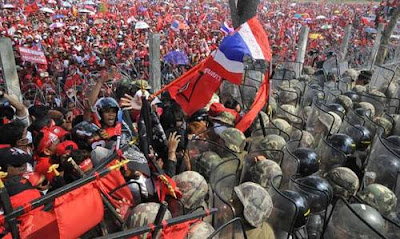
Bangkok was erupting with violence last night. Street fights and armed conflict between anti-government "Red Shirt" protesters and the Thai Army left 15 dead, including a Japanese journalist observing the protests, and more than 500 wounded in the Thai capital according to hospital officials. [source] Prime Minister Abhisit Vejjajiva went on national television shortly before midnight to pay condolences to families of the victims and indirectly assert that he would not bow to protesters' demands. [source]
The army had vowed to clear the "Red Shirt" protesters out of one of their two bases in Bangkok by nightfall, but the push instead set off a wave of deadly confrontations and street fighting. The Associated Press reports that there was a continuous sound of gunfire and explosions, mostly from Molotov cocktails, throughout the conflict. [source] Soldiers made repeated charges to clear the Red Shirts, while some tourists stood by watching. Two protesters and a Buddhist monk with them were badly beaten by soldiers and taken away by ambulance. Thai troops fired rubber bullets and tear gas, while protesters responded with home-made bombs and various smaller weapons. After more than two hours of fierce clashes, the soldiers pulled back. [source]

Several groups of anti-government protesters continue the call for new elections in Thailand.
As Army officials plead with the protest leaders through the media, asking them to retreat from where the currently are holding ground, senior government officials are attempting to open negotiations with the fierce anti-imperialist group.
The Red Shirt protesters are demanding that Prime Minister Abhisit Vejjajiva dissolve Parliament and call new elections. Their demonstrations are part of a long-running battle between the mostly poor and rural supporters of former Prime Minister Thaksin Shinawatra, and the ruling elite they say orchestrated the 2006 military coup that removed him from power. The Red Shirts see the Oxford-educated Abhisit as a symbol of an elite impervious to the plight of Thailand's poor and claim he took office illegitimately in December 2008 after the military pressured Parliament to vote for him. [source] Last month, thousands of Red-Shirt anti-government protesters poured blood in a symbolic act at the home of Prime Minister Abhisit Vejajjiva. [source]
Most of Saturday's fighting took place around Democracy Monument, which is near one of the encampments of the Red Shirt protesters. But it spread to the Khao San Road area, a favorite of foreign backpackers. Government forces have confronted the protesters before but pulled back rather than risk bloodshed. [source]
See Also: Thai Protests














2 comments:
There is a slight skew to your otherwise worthy summation. It essentially posits a rural poor vs. an urban elite (the emphasis on an Oxford education is interesting), but there is no mention of the nature of Red Shirt lead Thaksin, who came to power (or certainly left it) as a telecommunication billionaire. The conflict is not quite as clear as it is sometimes depicted in the West.
It's never completely transparent. And i'm sure there are sub-factions and would-be dictators, but at least the people are voicing their 'concerns'.
The Thai need to resist Haliburton, Bectel and others, if they stand a chance of retaining local power.
What do you think Thaksin's motives are?
Post a Comment